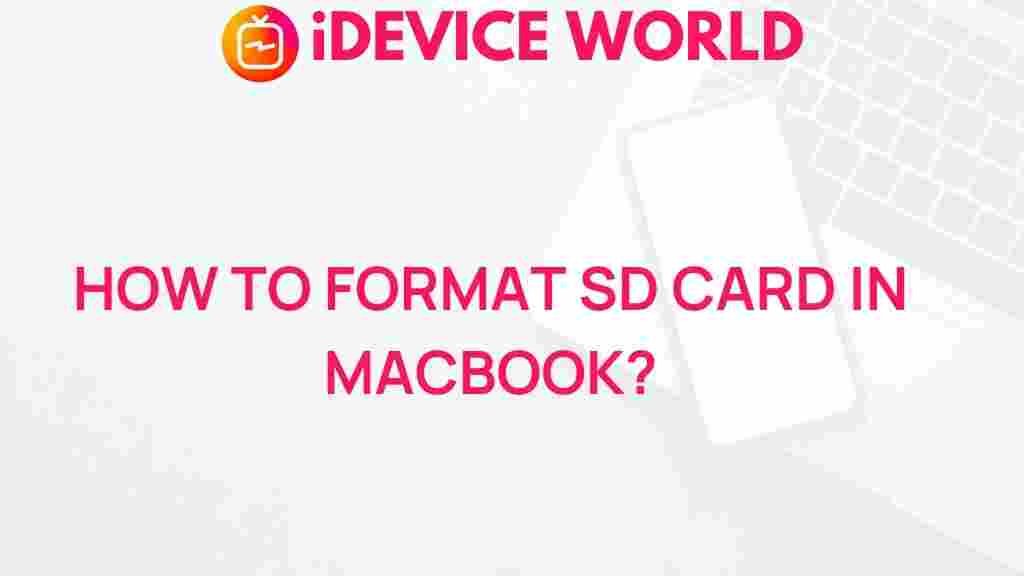Format Your SD Card: Unlock the Secrets of Formatting an SD Card on Your MacBook
If you own a MacBook and are looking to use an SD card, knowing how to format it correctly is essential. Whether you’re preparing to store photos, documents, or other files, formatting your SD card ensures it operates efficiently and is compatible with your MacBook. In this comprehensive guide, we will explore the steps for formatting an SD card on your MacBook, common troubleshooting tips, and best practices to follow.
Why You Need to Format Your SD Card
Formatting your SD card is crucial for several reasons:
- Clearing Old Data: Formatting removes all existing data, allowing you to start fresh.
- Ensuring Compatibility: Some devices may require specific formats to recognize the card.
- Improving Performance: Regular formatting can help maintain optimal speed and functionality.
Understanding Different Formats
Before we dive into the formatting process, it’s essential to understand the different file systems you can choose from when formatting your SD card:
- FAT32: The most widely compatible format for SD cards, supporting files up to 4GB.
- exFAT: Ideal for larger files (over 4GB) and commonly used for SDXC cards.
- APFS: A newer format optimized for SSDs and newer macOS versions, but less compatible with other devices.
How to Format an SD Card on Your MacBook
Follow these step-by-step instructions to format your SD card on a MacBook:
Step 1: Insert Your SD Card
Begin by inserting your SD card into the SD card slot on your MacBook. If your MacBook doesn’t have a slot, use an external card reader.
Step 2: Open Disk Utility
To access Disk Utility:
- Click on the Finder icon in the dock.
- Navigate to Applications > Utilities > Disk Utility.
Step 3: Select Your SD Card
In Disk Utility, you’ll see a list of available drives. Locate and select your SD card from the list on the left side of the window.
Step 4: Click on Erase
With your SD card selected, click on the Erase button located at the top of the Disk Utility window. This action opens a dialog box for formatting options.
Step 5: Choose a Format
In the erase dialog box, you will need to:
- Select a Name for your SD card.
- Choose a Format from the dropdown menu (FAT32, exFAT, or APFS).
- Optionally, select a Scheme (GUID Partition Map is often recommended).
Step 6: Confirm the Formatting
Once you’ve made your selections, click the Erase button to format your SD card. This process may take a few moments.
Step 7: Eject Your SD Card
After the formatting is complete, safely eject your SD card by clicking the eject icon next to its name in the Finder sidebar.
Common Issues and Troubleshooting Tips
Sometimes, you may encounter issues while formatting your SD card. Here are some common problems and their solutions:
1. SD Card Not Recognized
If your SD card isn’t showing up in Disk Utility, try the following:
- Check if the card is properly inserted.
- Try a different SD card slot or external reader.
- Restart your MacBook and try again.
2. Formatting Errors
If you encounter an error during formatting, consider these tips:
- Ensure the SD card isn’t locked (check for a physical switch on the card).
- Try formatting the card on another device to see if the issue persists.
- Use the Terminal for formatting if Disk Utility fails:
- Open Terminal from Applications > Utilities.
- Type diskutil list to find your SD card.
- Then use the command diskutil eraseDisk FAT32 YourCardName /dev/diskX, replacing X with your disk number.
3. Slow Performance
If your SD card is running slow, try the following:
- Format the card to optimize performance.
- Regularly clear unnecessary files and data.
- Consider using a high-speed card for better performance.
Best Practices for SD Card Maintenance
To ensure your SD card remains in optimal condition, follow these best practices:
- Regular Formatting: Format your SD card periodically, especially after transferring large amounts of data.
- Safely Eject: Always eject the card properly to avoid data corruption.
- Keep Backups: Regularly back up important data stored on your SD card.
Additional Resources
For more information on managing storage devices on your Mac, visit Apple’s official support page. You can also check out our other articles for tips on optimizing your MacBook’s performance.
Conclusion
Formatting your SD card on a MacBook is a straightforward process that can greatly enhance its performance and usability. By following the steps outlined in this guide, you can ensure your SD card is correctly formatted and ready for use. Remember to keep best practices in mind to maintain the longevity and efficiency of your storage device. If you encounter any issues, refer to our troubleshooting tips for assistance. Happy formatting!
This article is in the category Guides & Tutorials and created by iDeciveWorld Team
